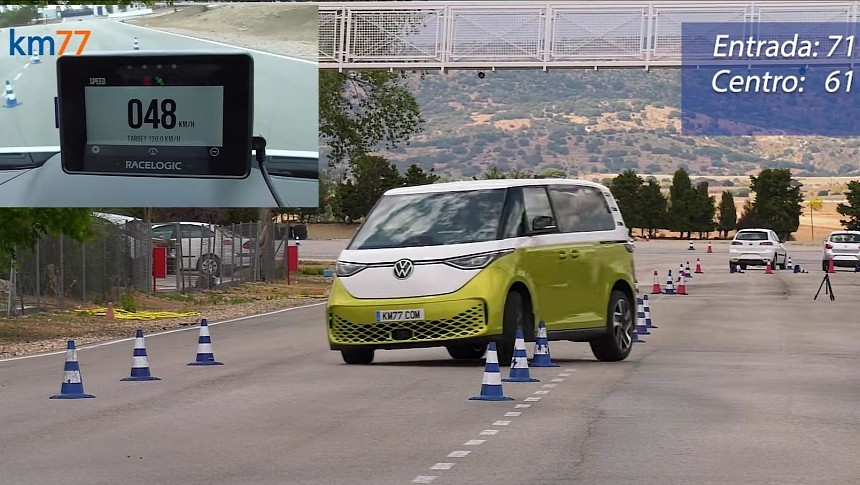Electric vehicles are – by design – heavier than their internal combustion-powered equivalents. The sheer weight of the ID. Buzz is more than obvious in the moose test.
But strangely enough, the combustion-engined Multivan couldn't do better than 69 kilometers per hour, converting to 43 miles per hour. The ID. Buzz topped 71 kilometers per hour (44 miles per hour) without hitting a single cone, albeit there's way more intervention from the ESC than in the Multivan.
Part of the reason the ID. Buzz in the first clip below did better is tire choice. More specifically, Continental EcoContact rubber measuring 265/45 by 20 inches compared to Bridgestone Turanza tires measuring 235/50 by 18 inches. In terms of tire width, make that 10.4 inches versus 9.3 inches for the ICE minivan.
It's also worth remembering that internal combustion and electric minivans feature different weight distributions and different centers of gravity. With the battery integrated into the ID. Buzz's floor, it shouldn't come as a surprise that it did better in the moose test. Can the T7 redeem itself in the slalom?
The answer is – unfortunately for ICE loyalists – negative. As opposed to 25.7 seconds for the ID. Buzz, the plug-in hybrid Multivan in the second video below needed 26.5 seconds to complete the slalom test.
In production since 2021, the T7 Multivan is based on Volkswagen's MQB architecture. It's a five-out-of-five-star vehicle in terms of safety according to Euro NCAP, yet Volkswagen doesn't sell this fellow stateside.
On the upside, you'll soon be able to purchase an ID. Buzz in the United States of America. Scheduled to arrive in dealer showrooms in 2024, the electric people carrier is rocking a long wheelbase by default. Over in Europe, only the ID. Buzz SWB is currently in production. Come 2024, the LWB will join it at commercial vehicles assembly plant in Hanover.
Volkswagen intended to manufacture the long-wheelbase version in the United States as well, over in Tennessee at the Chattanooga assembly plant. But alas, the plan was nipped in the bud once Volkswagen realized there wouldn't be enough demand in the US and Canada to warrant production in North America.
Heavily inspired by the Microbus we all know and love, the ID. Buzz can be had as a panel van or as a passenger van in Europe. For the United States and Canada, a three-row passenger version will have to suffice due to the aforementioned lack of consumer demand.
Revealed on June 2, the ID. Buzz LWB comes with a rear-mounted electric motor and a 91-kWh battery. Capable of no more than 99 miles per hour (160 kilometers per hour), the ID. Buzz LWB will be offered with a dual-motor setup as well. Don't look forward to a big difference in power, though. The AWD version cranks out 330 ponies compared to 282 for RWD.
Part of the reason the ID. Buzz in the first clip below did better is tire choice. More specifically, Continental EcoContact rubber measuring 265/45 by 20 inches compared to Bridgestone Turanza tires measuring 235/50 by 18 inches. In terms of tire width, make that 10.4 inches versus 9.3 inches for the ICE minivan.
It's also worth remembering that internal combustion and electric minivans feature different weight distributions and different centers of gravity. With the battery integrated into the ID. Buzz's floor, it shouldn't come as a surprise that it did better in the moose test. Can the T7 redeem itself in the slalom?
The answer is – unfortunately for ICE loyalists – negative. As opposed to 25.7 seconds for the ID. Buzz, the plug-in hybrid Multivan in the second video below needed 26.5 seconds to complete the slalom test.
In production since 2021, the T7 Multivan is based on Volkswagen's MQB architecture. It's a five-out-of-five-star vehicle in terms of safety according to Euro NCAP, yet Volkswagen doesn't sell this fellow stateside.
On the upside, you'll soon be able to purchase an ID. Buzz in the United States of America. Scheduled to arrive in dealer showrooms in 2024, the electric people carrier is rocking a long wheelbase by default. Over in Europe, only the ID. Buzz SWB is currently in production. Come 2024, the LWB will join it at commercial vehicles assembly plant in Hanover.
Volkswagen intended to manufacture the long-wheelbase version in the United States as well, over in Tennessee at the Chattanooga assembly plant. But alas, the plan was nipped in the bud once Volkswagen realized there wouldn't be enough demand in the US and Canada to warrant production in North America.
Heavily inspired by the Microbus we all know and love, the ID. Buzz can be had as a panel van or as a passenger van in Europe. For the United States and Canada, a three-row passenger version will have to suffice due to the aforementioned lack of consumer demand.
Revealed on June 2, the ID. Buzz LWB comes with a rear-mounted electric motor and a 91-kWh battery. Capable of no more than 99 miles per hour (160 kilometers per hour), the ID. Buzz LWB will be offered with a dual-motor setup as well. Don't look forward to a big difference in power, though. The AWD version cranks out 330 ponies compared to 282 for RWD.






















